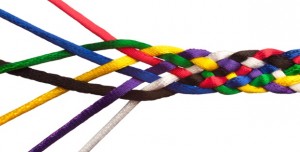Making Connections
Teaching English is like making friendship bracelets: you are given a tangled web of different people and their cultures and backgrounds they bring with them, and you have topics and perspectives you need to cover, and somehow you weave them all together into a beautiful pattern.
You may start with some of the same strings, or topics, every year, but you never know where you’re going to go. You may even make some mistakes at the beginning. But with each new year and new students, you end up making a different, yet still beautiful, pattern. For example, to wrap up a book about Rosa Parks and segregation laws changing, I asked students to write about one law or rule they would like to change. One time, I had several Spanish-speaking ELL students, and they wrote about changing the immigration laws so their people could work legally and not be treated as criminals. Another time, I had students who played football and were more interested in the school rules about not playing when your grades were too low. Different students will bring in different strings that are interesting to them. They add color and variety to our friendship bracelets. As an English teacher, I have the joy of weaving all the strings I am given together and helping my students to do this too. I will also help them to see and admire the diversity- in race and gender, yes, but also in ideas, opinions, and perspectives- that we share as a class.
You can show someone how to make a friendship bracelet, but they learn best by making one themselves. They will understand much better when it is their fingers that are weaving the strings into a pattern of their choosing, even when they tie knots where they shouldn’t go, and have to figure out how to untangle them. Students learn best when they are set free with something “hands-on,” and making mistakes is part of learning. I could lecture all I wanted about prepositional phrases and independent clauses, but students won’t really learn until they put it to the test in their writing. They will make mistakes, but fortunately mistakes in typed or even handwritten papers are easier to fix than knots in friendship bracelets. Of course, I will still be there, giving them step-by-step instructions, showing them worthy examples of patterns to follow, and troubleshooting when all the strings are hopelessly knotted.
One string that I will always include in my classroom, or “bracelet,” no matter what, is our Lord and Savior. Every day in my classroom, we will either start our discussion or turn back to Jesus and see what He has to say about a matter, or even just be completely focused on for our whole class period. If we’re reading a book, we will naturally discuss whether each character is doing what God would have them do, which commandments apply in those situations, and what students would do in those situations. Even when applying grammar to our writing, we can still do our best, so as to glorify and thank God for the blessings He’s given us and honor our families, teachers, and the community. Jesus “ties in” to everything. As He says in John 15, “I am the vine and you are the branches…Remain in me and I will remain in you. Apart from me you can do nothing.” Without God, I would not have the strength or ability to teach my classroom well. I will make sure my students are aware of that fact about me, and remind them that it is true of them as well. This is the most important string that I will always include in my teaching and in my classroom.

